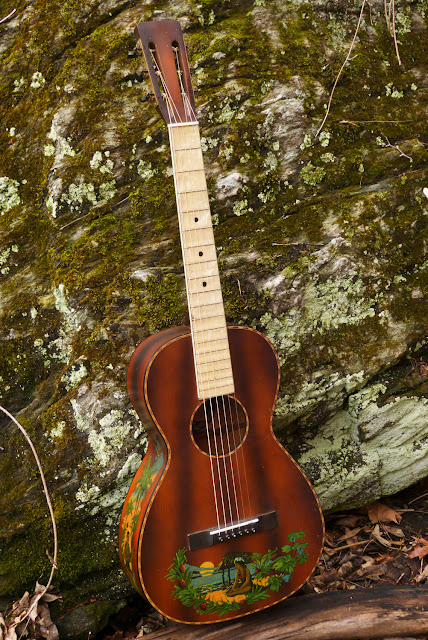1930s Harmony-made Supertone "Hawaiian" Parlor Guitar
Well, at least I think it's a '37 -- the red date stamp is awfully smudged. But, yes, this is yet another incarnation of the "standard 12 fret Harmony" from the 1930s. This one has a Supertone (Sears-sold) label in the soundhole, and I've worked on variations of this guitar many times. Strung "Hawaiian" style with raised strings they have a sweet, airy, sing-song voice and setup "Spanish" style they make good, mellow, articulate fingerpicking guitars -- though I have to admit I'm not as much into the flatpicked sound on these unless the player's touch is light.
Specs-wise, it's just-under 0 size with a 13" lower bout and a short, 24 1/8" scale length. The body is solid birch throughout, though it has a finish that gives a faux-mahogany appearance. This one is a little more deluxe than usual and has a bound, pearloid-surfaced fretboard, black binding at the top and back edges of the body, and nice wood purfling around the top edge. Overall condition is excellent in that it has zero cracks and is entirely original except for replacement (ebony) pins and a new saddle.
I worked on this for a customer and it received a neck reset, fret seating, fret level/dress, one brace reglue, recut of the saddle slot and a new (compensated) bone saddle, and general setup. Because these are built so lightly, I've strung it with 46w-10 "extra light" strings. The feel is sort of "classical" in tension but works nicely for fingerpicking.
I think the effect of the faux-mahogany sunburst-ish finish and the decals is tres cool.
The 1 3/4" bone nut is original. Note the usual "crested" Harmony headstock shape.
Every time I have a pearloid-boarded guitar in that needs fret work (they all do), I soak some thin superglue into the fret slots to make sure they're seated beforehand. This type of board often distorts over time and the frets don't hold "the way they used to."
I added side dots, though the painted "face dots" are original.
The cool wooden purfling wasn't originally so muted -- the pale green stripes were a vibrant, emerald green and the pale brown was a bright yellow when it was made (this can be seen when the fretboard is lifted off of it).
Ironically, Harmony actually glued the original bridge in such a way that the front edge of the original saddle slot was compensated. Still, it needed a new saddle after the neck set and so I expanded the slot wider front/back to install a new bone saddle with better compensation.
I've always loved seeing this crazy decal on these old Harmony boxes. The pineapples remind me more of pinecones, though!
The original tuners are going strong after a lube.























Comments
The top is thin and was bent inwards near the neck so I was afraid of trying to pull the neck back too far for fear of cracking the top, even after replacing a missing brace underneath, but at some point I started wondering if the neck was ever supposed to be straight enough so you could play it as a parlor guitar and not using a slide.
I'm not showing a photo of the back so you can't see how abominable a job I did getting the back to fit on properly despite my best efforts at pushing and shoving and clamping.
https://photos.app.goo.gl/jDWyMKF7UdvDSDMg9